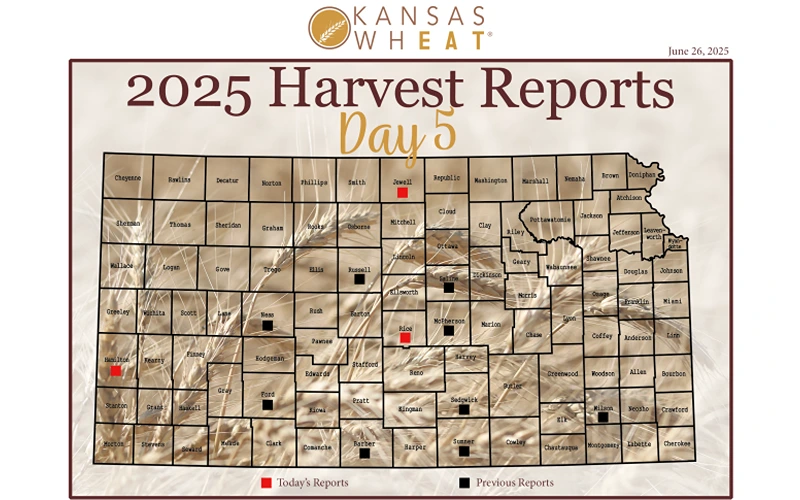This is day 5 of the Kansas Wheat Harvest Reports, brought to you by the Kansas Wheat Commission, Kansas Association of Wheat Growers, Kansas Grain and Feed Association and the Kansas Cooperative Council.
Harvest is progressing steadily across parts of Kansas, with yields generally around average despite challenges like strong winds, scattered rain and wheat streak mosaic virus. Weather and market conditions remain obstacles. Growers are staying optimistic and focused on finishing the season successfully.
Jess Schwieterman, who farms with his wife Laryce in Hamilton County near Syracuse, reports that this year’s harvest has been going well, despite strong winds and a few rain showers. They received a good November rain, but no winter moisture and a dry March and April until it started raining the week after Easter. The grain fill conditions were excellent, and yields have been right around average, similar to last year. Test weights have held up around 60 to 61 pounds per bushel.
High winds brought in a spring infection of Wheat Streak Mosaic Virus, turning the fields yellow. Schwieterman mentioned several varieties that have proven to have good resistance – KS Territory, KS Bill Snyder and KS Dallas. Their harvest began on June 20 and is nearly halfway finished. However, others in the area are just getting started. They have been pleased with yields, noting that the longer the fields are in no-till, the better they yield. They also manage for higher yields and have a strong fertility program. The biggest challenge this year has been the depressed wheat prices.
Kris Allen, general manager of Randall Farmers Coop in Jewell County, reports that harvest has been moving steadily across their two locations. Since taking in their first load on June 16, they’ve brought in around 700,000 bushels. Yields are ranging from 45 to 60 bushels per acre, and protein levels are holding solid at 12.6. Depending on the area, fields are about halfway to two-thirds cut, with combines rolling steadily. While this year isn’t quite as massive as last year’s crop, fueled by failed acres the season before, it’s still shaping up to be a strong and successful year.
Over halfway done with harvest, Brian Sieker, a farmer in Rice county, is facing the challenges of a wet season head-on, and staying optimistic.
“Mud is a challenge, but we’re grateful for it,” Sieker said. “Moisture is a welcome sight for our crop.”
On average, fields have produced 40-70 bushels per acre. Wheat Streak Mosaic Virus (WSMV) has taken a toll on both yield and test weight this year, prompting a change in how he’ll select varieties going forward.
“In the future, I will be taking varieties for WSMV; I haven’t in the past,” Sieker said. “We have to protect our neighbors because the investment is huge and margins are thin.”
With winter in mind, Sieker said he’s glad to have residue left in the fields. “It’s nice to have the stubble. It will hold us through the winter.”
Above all, he encourages others to check in with each other and find joy in the season.
“Check on your neighbors,” he said. “Enjoy the process. Harvest is a fun but stressful time.”
The 2025 Harvest Report is brought to you by the Kansas Wheat Commission, Kansas Association of Wheat Growers, Kansas Grain and Feed Association and the Kansas Cooperative Council. To follow along with harvest updates on social media, use #wheatharvest25. Tag us at @kansaswheat to share your harvest story and photos.


























































